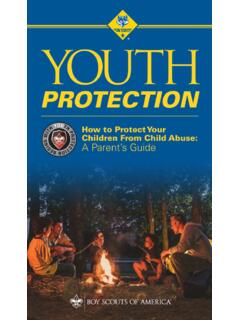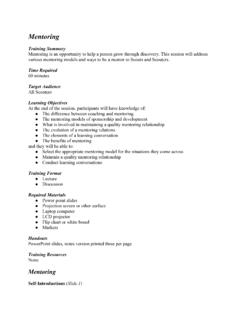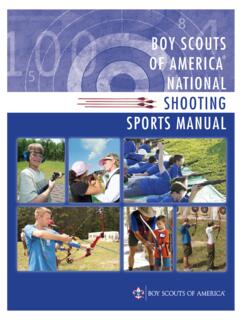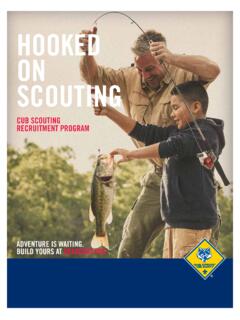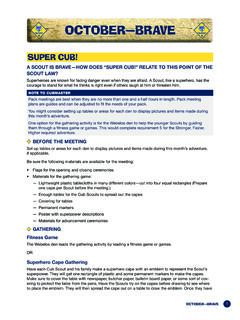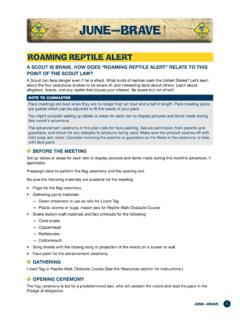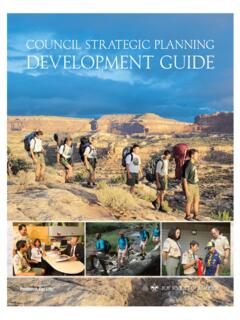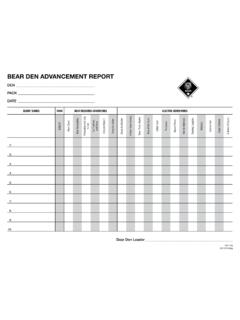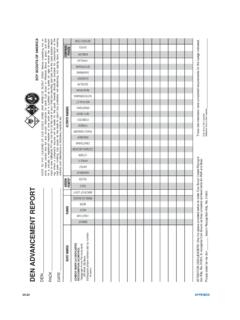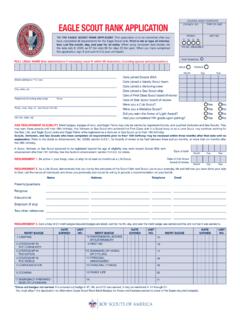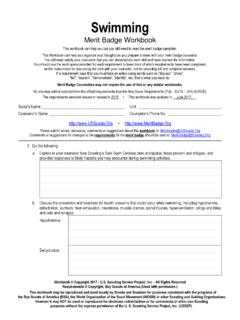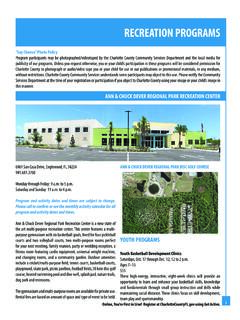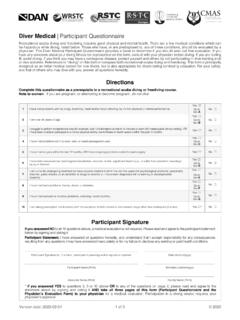Transcription of SWIMMING - Scouting
1 SWIMMING . BOY SCOUTS OF AMERICA. MERIT BADGE SERIES. SWIMMING . Enhancing our youths' competitive edge through merit badges . Requirements 1. Do the following: a. Explain to your counselor how Scouting 's Safe Swim Defense plan anticipates, helps prevent and mitigate, and provides responses to likely hazards you may encounter during SWIMMING activities. b. Discuss the prevention and treatment of health concerns that could occur while SWIMMING , including hypothermia, dehydration, sunburn, heat exhaustion, heatstroke, mus- cle cramps, hyperventilation, spinal injury, stings and bites, and cuts and scrapes. 2. Before doing the following requirements, successfully complete the BSA swimmer test: Jump feetfirst into water over the head in depth. Level off and swim 75 yards in a strong manner using one or more of the following strokes: sidestroke, breaststroke, trudgen, or crawl; then swim 25 yards using an easy, resting backstroke. The 100 yards must be completed in one swim without stops and must include at least one sharp turn.
2 After completing the swim, rest by floating. 3. Swim continuously for 150 yards using the following strokes in good form and in a strong manner: front crawl or trudgen for 25 yards, back crawl for 25 yards, sidestroke for 25 yards, breaststroke for 25 yards, and elementary backstroke for 50 yards. 4. Do the following: a. Demonstrate water rescue methods by reaching with your arm or leg, by reaching with a suitable object, and by throwing lines and objects. Explain why SWIMMING rescues should not be attempted when a reaching or throwing rescue is possible, and explain why and how a rescue swimmer should avoid contact with the victim. 6 SWIMMING . b. With a helper and a practice victim, show a line rescue both as tender and as rescuer. The practice victim should be approximately 30 feet from shore in deep water. 5. Do the following: a. Float faceup in a resting position for at least one minute. b. Demonstrate survival floating for at least five minutes.
3 C. While wearing a properly fitted Coast Guard approved life jacket, dem- onstrate the HELP and huddle positions. Explain their purposes. d. Explain why SWIMMING or survival float- ing will hasten the onset of hypothermia in cold water. 6. In water over your head, but not to exceed 10 feet, do each of the following: a. Use the feetfirst method of surface diving and bring an object up from the bottom. b. Do a headfirst surface dive (pike or tuck), and bring the object up again. c. Do a headfirst surface dive to a depth of at least 5 feet and swim underwater for three strokes. Come to the surface, take a breath, and repeat the sequence twice. 7. Following the guidelines set in the BSA Safe Swim Defense, in water at least 7 feet deep*, show a standing headfirst dive from a dock or pool deck. Show a long shallow dive , also from the dock or pool deck. *If your state, city, or local community requires a water depth greater than 7 feet, it is important to abide by that mandate.
4 8. Explain the health benefits of regular aerobic exercise, and discuss why SWIMMING is favored as both fitness and thera- peutic exercise. SWIMMING 7.. SWIMMING Resources SWIMMING Resources Scouting Literature . Total Immersion: The Boy Scout Handbook; Deck of First Revolutionary Way to Swim Better, Aid; Emergency First Aid pocket guide; Faster, and Easier. Touchstone, 2004. Athletics, Emergency Preparedness, First Lenihan, Daniel J. Underwater Wonders Aid, Lifesaving, Personal fitness , Scuba of the National Parks. Compass Diving, Sports, and Water Sports merit America Guides, 1997. badge pamphlets Montgomery, Jim, and Mo Chambers. Mastering SWIMMING . Human Visit the Boy Scouts of America's Kinetics, 2008. official retail Web site at http:// Orr, Dan, and Eric Douglas. Scuba for a com- Diving Safety. Human Kinetics, 2007. plete listing of all merit badge Salo, David, and Scott Riewald. pamphlets and other helpful Complete Conditioning for SWIMMING .
5 Scouting materials and supplies. Human Kinetics, 2008. Thomas, David G. SWIMMING : Books Steps to Success, 3rd ed. Human Kinetics, 2012. Barsky, Steven M. The Simple Guide to Snorkeling Fun. Best Publishing Company, 1999 Organizations and Colwin, Cecil M. Breakthrough Web Sites SWIMMING . Human Kinetics, 2002. American Red Cross Graver, Dennis K. Scuba Diving, 4th ed. Toll-free telephone: 800-733-2767. Human Kinetics, 2009. Web site: Hines, Emmett W. fitness SWIMMING , USA SWIMMING 2nd ed. Human Kinetics, 2008. Web site: Laughlin, Terry. Extraordinary YMCA of the USA. SWIMMING for Every Body. Total Telephone: 312-977-0031. Immersion SWIMMING , 2006. Web site: SWIMMING 61.
